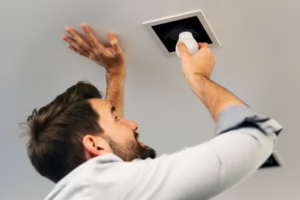Shed lighting is essential to making it a useful room, be it a storage shed, a facility workshop, or a leisure room. LED lights use less power and last longer, but need power to run. Here is where rechargeable batteries come in as the best option as they provide a sustainable and flexible way to go without extensive wiring or electrical work.
What You Need to Know about LED Lighting and Why it is Beneficial to Sheds
LED (Light Emitting Diode) lighting is popular for being energy efficient as well as long-lasting, which makes it ideally suited for use in shed environments. These light bulbs use less power than the regular type and this means they waste much less energy in the form of heat, thus lowering the fire risk. Also, they last for many years and therefore do not need to be replaced every few months, a big bonus in hard-to-reach places such as sheds.
Rechargeable Battery Types: Advantages and Disadvantages
There are a few different kinds of rechargeable batteries, each with its pros and cons:
- Lead-Acid Batteries: Lead-acid batteries are commonly used, with a reasonable price tag and high availability. But compared to other types, these types are heavier, and have a shorter lifespan.
- Nickel-Cadmium (NiCd) Batteries: While effectively performing in cold temperatures with solid cycle life, they can exhibit memory effect and are toxic.
- Lithium-Ion (Li-ion) Batteries: The best in terms of energy density, and slowest to lose charge when stored, but tend to be more expensive.
- Nickel-Metal Hydride (NiMH) Batteries: More eco-friendly than NiCd, same life as NiCd but less reduction due to memory problems.
What to Look for in Rechargeable Batteries for Shed LED Lights
There are several factors to consider when selecting the right battery:
- Capacity: The battery should store sufficient power to light up your lights for the required time.
- How to choose LED lights 02гџ The voltage: Make sure the battery voltage is the same as your LED lights.
- Durability: Choose batteries designed to handle temperature extremes and incremental charging cycles.
- Maintenance: How much effort and time do you want to dedicate to maintaining batteries?
- Price: Find the right compromise between price, performance and battery life.
Best Rechargeable Batteries for LED Shed Lights
1. LED Emergency Backup Driver 20W, 120V-347VAC, Rechargeable UL Approved Backup Battery
Store Name: LED Flying Direct
Pros:
- UL certified for quality and reliability.
- Provides over 90 minutes of emergency lighting.
- Suitable for various LED fixtures with or without dimmable function.
- Features high input and output voltage compatibility.
Cons:
- Higher price point compared to non-emergency drivers.
- Limited to LED fixtures that match specific power requirements.
Suggestion to Buy: Ideal for users needing reliable emergency lighting in environments like offices or commercial buildings where safety regulations require certified products.
2. 25W LED Emergency Backup Driver, Rechargeable LED Emergency Backup Battery for Dimmable UFO LED High Bay Light
Store Name: LED Flying Direct
Pros:
- UL listed ensuring safety and performance.
- Automatically switches to emergency mode during power failures.
- Compatible with high-power LED lights up to 200W.
- Equipped with protections against short circuit, overload, and overheating.
Cons:
- Only compatible with dimmable LED lights.
- Requires installation near a junction box, which may not be convenient for all setups.
Suggestion to Buy: Best for users with high wattage LED lighting systems who require a dimmable function, ensuring both regular and emergency operations.
3. TalentCell Rechargeable 12V DC Output Lithium ion Battery Pack for LED Strip/Light/Panel/Amplifier and CCTV Camera
Store Name: Talentcell Store
Pros:
- Very affordable compared to other options.
- Compact and portable, easy to integrate with various devices.
- Multi-LED indicator showing battery percentage.
- Includes necessary accessories like charger and splitter cable.
Cons:
- Limited to 12V devices, not suitable for high-power applications.
- 3000mAh capacity may not suffice for prolonged use without recharging.
Suggestion to Buy: Great for users looking for a versatile, budget-friendly battery pack for small-scale projects or portable electronics.
Each product offers distinct advantages depending on the specific needs and setup of your shed lighting or emergency systems. Choose according to the compatibility with your devices and the required safety features.
To assist you in making an informed decision, here are some of the biggest and well know companies in world:
- Duracell Recharge Ultra: For smaller sheds with a long life and low maintenance.
- Energizer Recharge Power Plus: A do-it-all battery that strikes a good savings/capacity trade-off.
- Panasonic Eneloop Pro: Ideal for high performance needs, especially in cold locations.
- Samsung 50E: A larger pack focused on capacity for long-running panels.
Maintaining and Extending Lifespan of Rechargeable Batteries
- To charge well, clean battery contacts often.
- Try not to discharge your battery completely; top it off before it runs out of juice.
- Keep batteries cool and dry to avoid their being prematurely aged.
- Find smart charging systems that avoid overcharging.
- Sustainable Living: Shed Lights with Solar-Powered or Wind-Powered Batteries
Install a battery system to store solar or wind energy to make your shed lighting even more eco-friendly. Solar panels or small wind turbines can power your batteries, creating an environmentally friendly, economical, and autonomous system.
Final Thoughts: Choosing the Right, Long-lasting and Eco-friendly Light for Your Shed
When selecting a rechargeable battery for your shed LED lights, you need to take into account your requirements, the advantages that different batteries have to offer, and various things that you can do to keep them in optimal working condition. Once you make the right choice, you can have a bright shed that supports convenience, safety, and sustainability.
FAQs
Which Rechargeable Battery is Suitable for Small Sheds?
Small sheds are usually fine with lead-acid or NiMH batteries.
Are ordinary car batteries suitable for my shed lights?
Car batteries are not designed for this as they discharge energy over long periods, whereas car batteries are designed to produce short bursts of heat/current, not long sustained outputs.
How do I calculate my shed lighting capacity requirements?
Add up the wattage of all the LED lights, estimate the total hours that they’ll be on for, and pick a battery that will deliver this capacity.
How can I tell if my rechargeable battery is swelling?
Stop using it immediately and replace it, because swelling could be a sign of a failure that could create a safety hazard.
Are batteries with the ability to recharge more cost efficient than non-rechargeable batteries?
Indeed, rechargeable batteries are cost-effective in the long-term as they last handed down better.
How do I know when to replace my rechargeable batteries?
This varies, but typically every 2-5 years depending on the battery type.
What can I use to power my LED lights?
Use batteries of the same type and capacity for balanced charging and discharging.
What is memory effect in batteries?
It occurs in some types of rechargeable batteries, where they hold less charge if not fully discharged before being recharged.
Are lithium-ion batteries safe for use in sheds?
Lithium-ion batteries need a protection circuit to prevent overcharge, overheating, and deep discharge.
Can an LED light be powered directly from a solar panel without a battery?
Now, while this may make it technically possible, it is impractical because it will only work whenever there is enough sunlight during the day, which means that a battery will be required to light a night.




